Demolition Contractors Doral
Find top Demolition Contractors in Doral
Receive 3 FREE Structure Demolition quotes for your project today! Compare profiles, reviews, accreditations, portfolio, etc... and choose the best service.
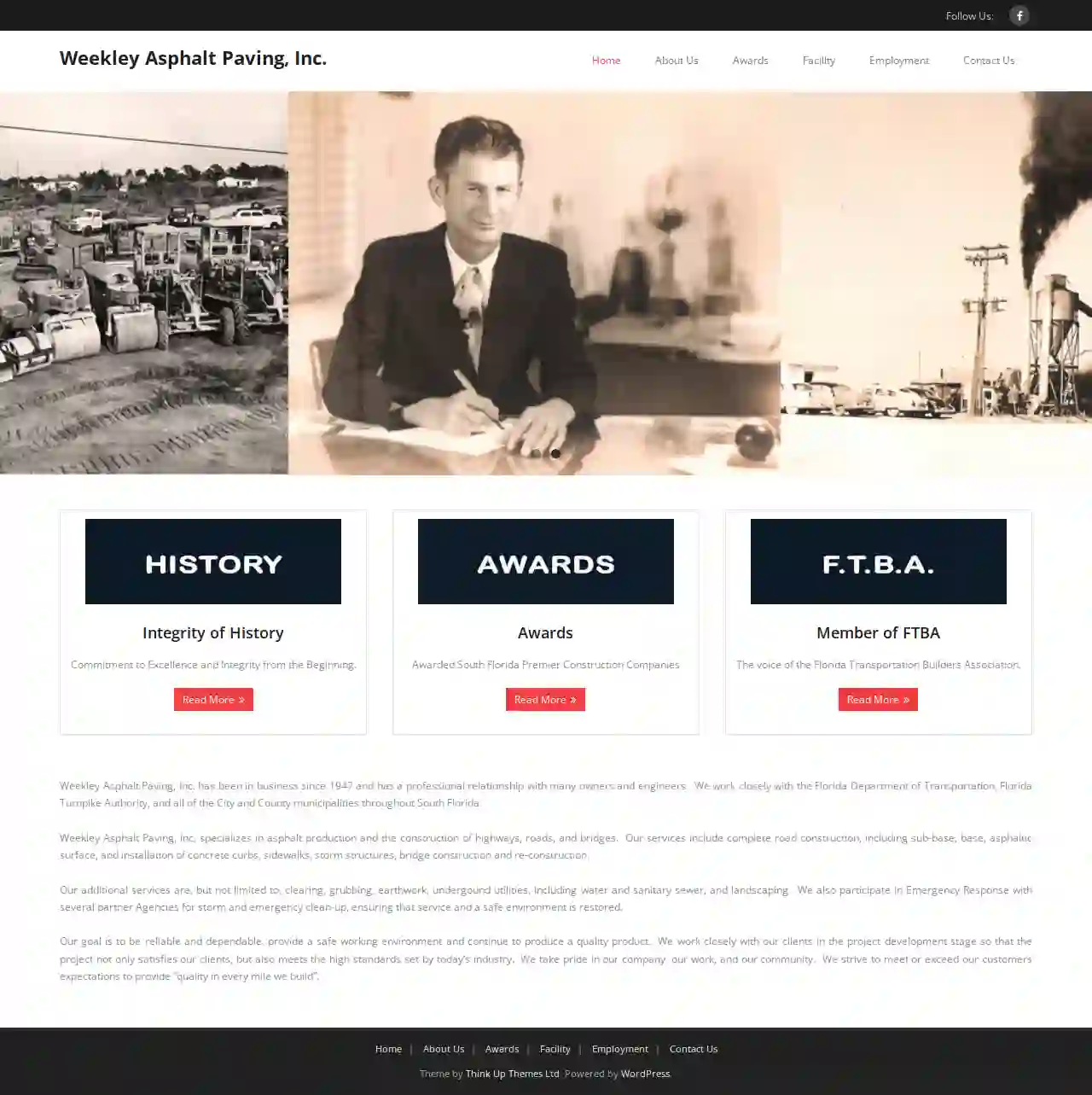
Weekley Asphalt Paving Inc
3.766 reviewsMiami, USIntegrity of History Commitment to Excellence and Integrity from the Beginning. Read More Awards Awarded South Florida Premier Construction Companies Read More Member of FTBA The voice of the Florida Transportation Builders Association. Read More Weekley Asphalt Paving, Inc. has been in business since 1947 and has a professional relationship with many owners and engineers. We work closely with the Florida Department of Transportation, Florida Turnpike Authority, and all of the City and County municipalities throughout South Florida. Weekley Asphalt Paving, Inc. specializes in asphalt production and the construction of highways, roads, and bridges. Our services include complete road construction, including sub-base, base, asphaltic surface, and installation of concrete curbs, sidewalks, storm structures, bridge construction and re-construction. Our additional services are, but not limited to, clearing, grubbing, earthwork, undergound utilities, including water and sanitary sewer, and landscaping. We also participate in Emergency Response with several partner Agencies for storm and emergency clean-up, ensuring that service and a safe environment is restored. Our goal is to be reliable and dependable, provide a safe working environment and continue to produce a quality product. We work closely with our clients in the project development stage so that the project not only satisfies our clients, but also meets the high standards set by today’s industry. We take pride in our company, our work, and our community. We strive to meet or exceed our customers expectations to provide “quality in every mile we build”.
- Services
- Why Us?
- Gallery
Get Quote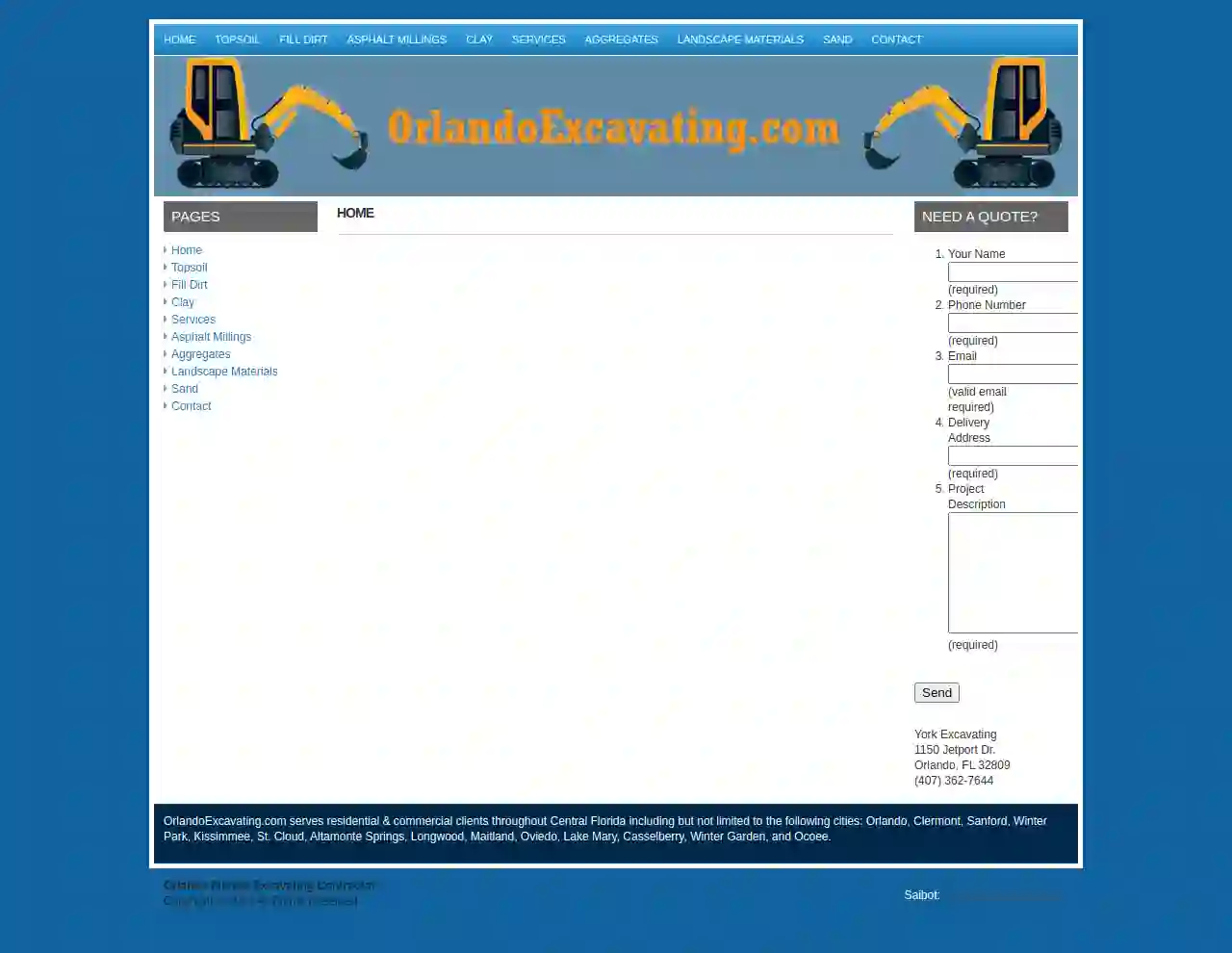
Orlando Florida Excavating Contractor
2.79 reviews1150 Jetport Dr., Orlando, 32809, USOrlando Excavating is a trusted excavating contractor serving residential and commercial clients throughout Central Florida. We offer a wide range of services, including topsoil, fill dirt, asphalt millings, clay, aggregates, landscape materials, and sand. Our team of experienced professionals is dedicated to providing high-quality services at competitive prices. We are committed to safety and environmental responsibility, and we strive to exceed our clients' expectations on every project. We are proud to serve the following cities in Central Florida: Orlando, Clermont, Sanford, Winter Park, Kissimmee, St. Cloud, Altamonte Springs, Longwood, Maitland, Oviedo, Lake Mary, Casselberry, Winter Garden, and Ocoee.
- Services
- Why Us?
Get Quote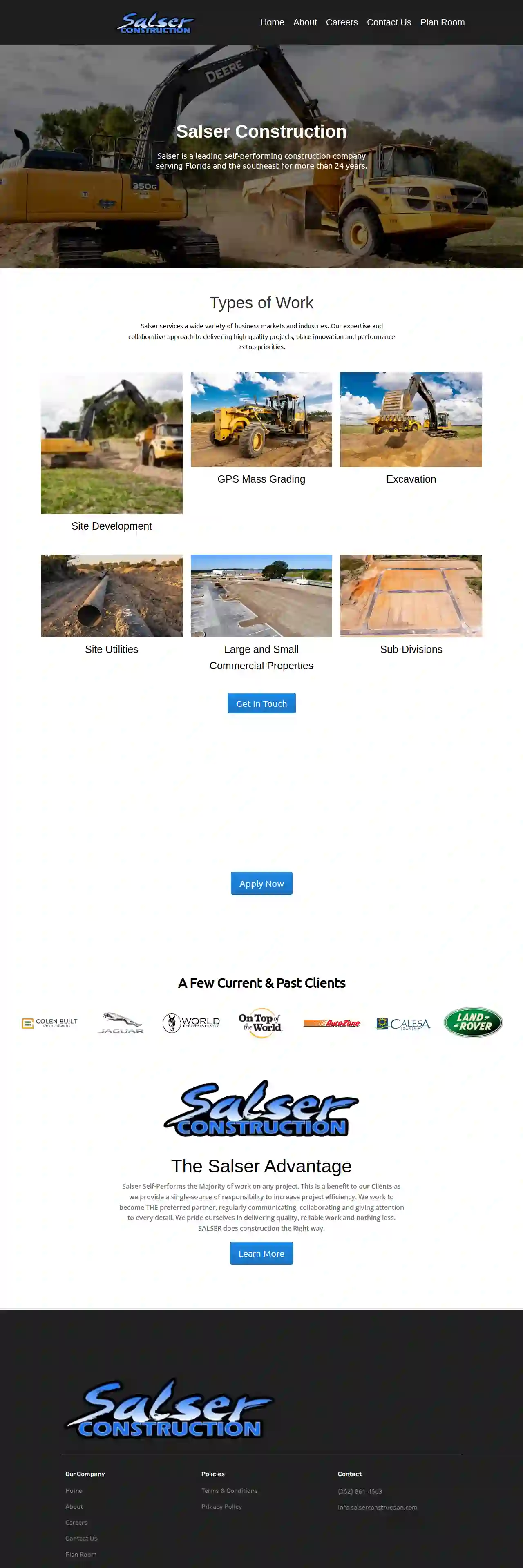
Salser Construction, LLC
3.522 reviews5025 NE 36th Avenue Rd, Ocala, 34479, USAbout Salser Construction Construction Solutions Since 1998 Our Story Salser Construction is a full-service site development company located in Ocala, FL. We are proud to be a leader in providing high-quality construction services to our customers. Our goal is to create successful partnerships with our customers to establish long-lasting relationships built on integrity and trust by exceeding expectations through exceptional planning and performance. What We Offer Our full scope of services includes: land clearing, mass earth moving and grading, underground utilities, fire lines, lift station rehabilitations, base and paving, concrete curb & gutter, complete road and street construction, and mining operations. Salser owners have three mines providing our crews with the lime rock base, sand, and clay. Our projects include municipal utilities, road construction, schools, residential subdivisions, and commercial site development. Our Mission Teamwork is the building block of our company. We believe every person in our organization is essential to correctly completing a project. That leads us to put our employees' health, safety, and well-being as our highest priority. Salser has several highly qualified long-term employees and recently added members to form a strong team to deliver every project on time and within budget. Our mission is to maintain the highest level of professionalism, integrity, and honesty with our suppliers, subcontractors, professional associates, and customers, to provide a quality product in a timely fashion, to continuously exceed expectations, and to serve with a character and purpose that brings honor to God. We would appreciate the opportunity to work with your team on any upcoming projects you have in the central Florida area.
- Services
- Why Us?
- Gallery
Get Quote
Lewis Industries Group LLC
54 reviewsTallahassee, USPrecision. Punctuality. Commitment to excellence. At Lewis Industries, we live and breathe the work that we do. We specialize in grading, excavation, drainage systems, and site preparation.
- Services
- Why Us?
- Gallery
Get Quote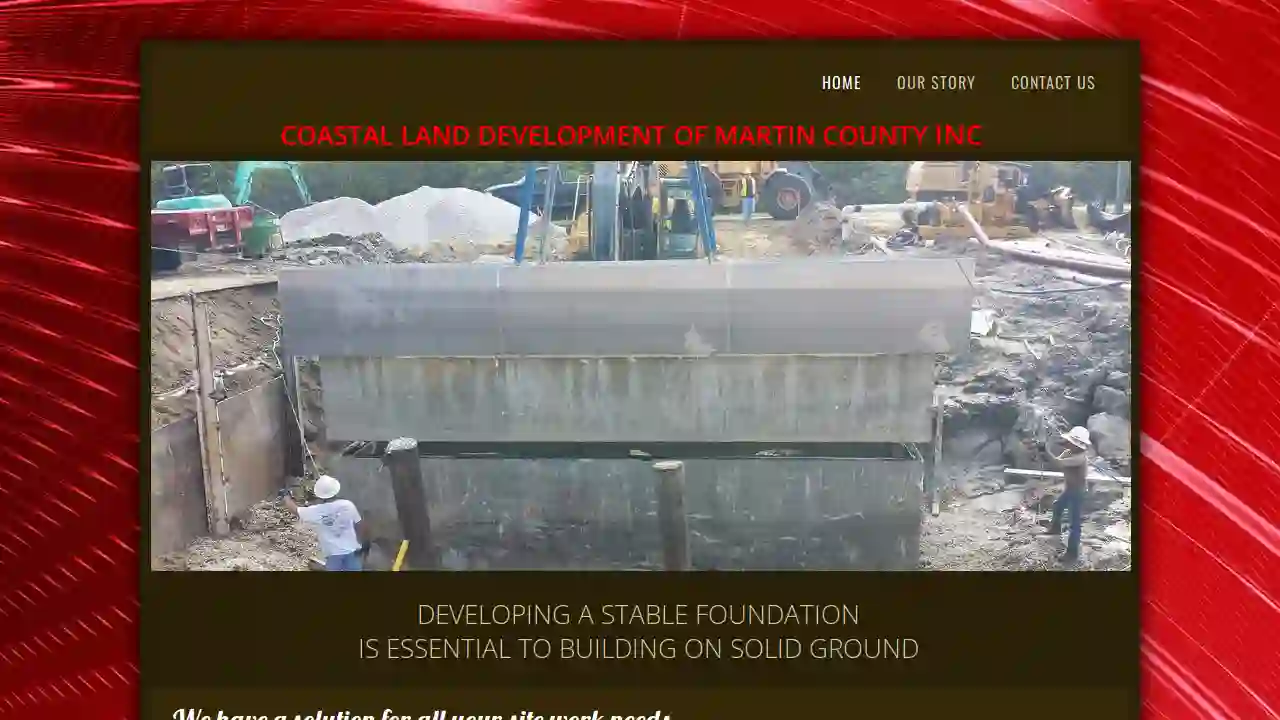
Coastal Land Development of Martin County, Inc.
32 reviews5640 SE Grouper Avenue, Stuart, 34997, USCoastal Land Development: Your Trusted Partner for Site Work Coastal Land Development of Martin County, Inc. is more than just a site work contractor. We provide comprehensive earthwork and utilities services, along with the equipment to get the job done right. But we go beyond that. We offer the knowledge and skills needed to make your project a success, ensuring you're completely satisfied. Our team is comprised of highly skilled and experienced professionals who are dedicated to delivering exceptional results. We take pride in our work and are committed to providing excellence in every aspect of our operations. We understand that site development is an exacting job, requiring years of training and experience. That's why we specialize in this field and guarantee our work. We are committed to maintaining the highest level of quality and delivering efficient results, even on the most demanding schedules. Our owner, Osiris Ramos, is a graduate of the University of Florida with over 30 years of experience in the construction industry, specializing in site development. He holds a Florida Certified General Contractors License (#CGC1522920). Our field team boasts an average of 25+ years of construction industry experience. Our office is managed by an MBA graduate of Florida Atlantic University with nearly 30 years of business/finance, administrative, and client service experience. We are conveniently located in Stuart, Martin County, Florida, and are ready to mobilize our company-owned equipment immediately on site. We are constantly adding to and upgrading our fleet of equipment to meet the needs and schedule of each project. Choose Coastal Land Development for your site work needs and experience the difference of working with a team that is committed to excellence, efficiency, and your complete satisfaction.
- Services
- Why Us?
- Our Team
- Gallery
Get Quote
J&T Bush Hogging, Land Clearing and Excavation LLC.
4.25 reviewsMadison, 32340, USGet Ready to Build on Your Land J&T Bush Hogging, Land Clearing and Excavation can prepare your site for your construction project. Turning your rugged, overgrown land into a fully prepared construction site doesn't have to be difficult. When you work with J&T Bush Hogging, Land Clearing and Excavation, it can be a simple and streamlined process. Our land clearing company offers a wide range of services in the Madison, Monticello & Live Oak, FL area. What can we do for you? Our team can prepare your residential or commercial site for a construction project. You can count on us to: Clear your land Demolish a building Excavate for a foundation We can also provide services like brush hogging, tree pruning and utility trenching. Call 850-673-8071 now to explore all of the options with a local excavation contractor. We're available 24/7 for emergency calls. You can also email us by using the form on the Contact Us page. After a Storm Passes, Who Can Clear the Damage? Our land clearing company is available 24/7 in the Madison, Monticello & Live Oak, FL area. Why choose J&T Bush Hogging, Land Clearing and Excavation? When you need a land clearing company, you need one with experience and high-quality equipment. Our crew has more than 20 years of experience and a stock of Bobcats, excavators and other vehicles and machinery. Reach out to our excavation contractors today to get a free estimate on any of our services. Please note that an estimate fee may apply for clients outside of our normal service radius.
- Services
- Why Us?
- Gallery
Get Quote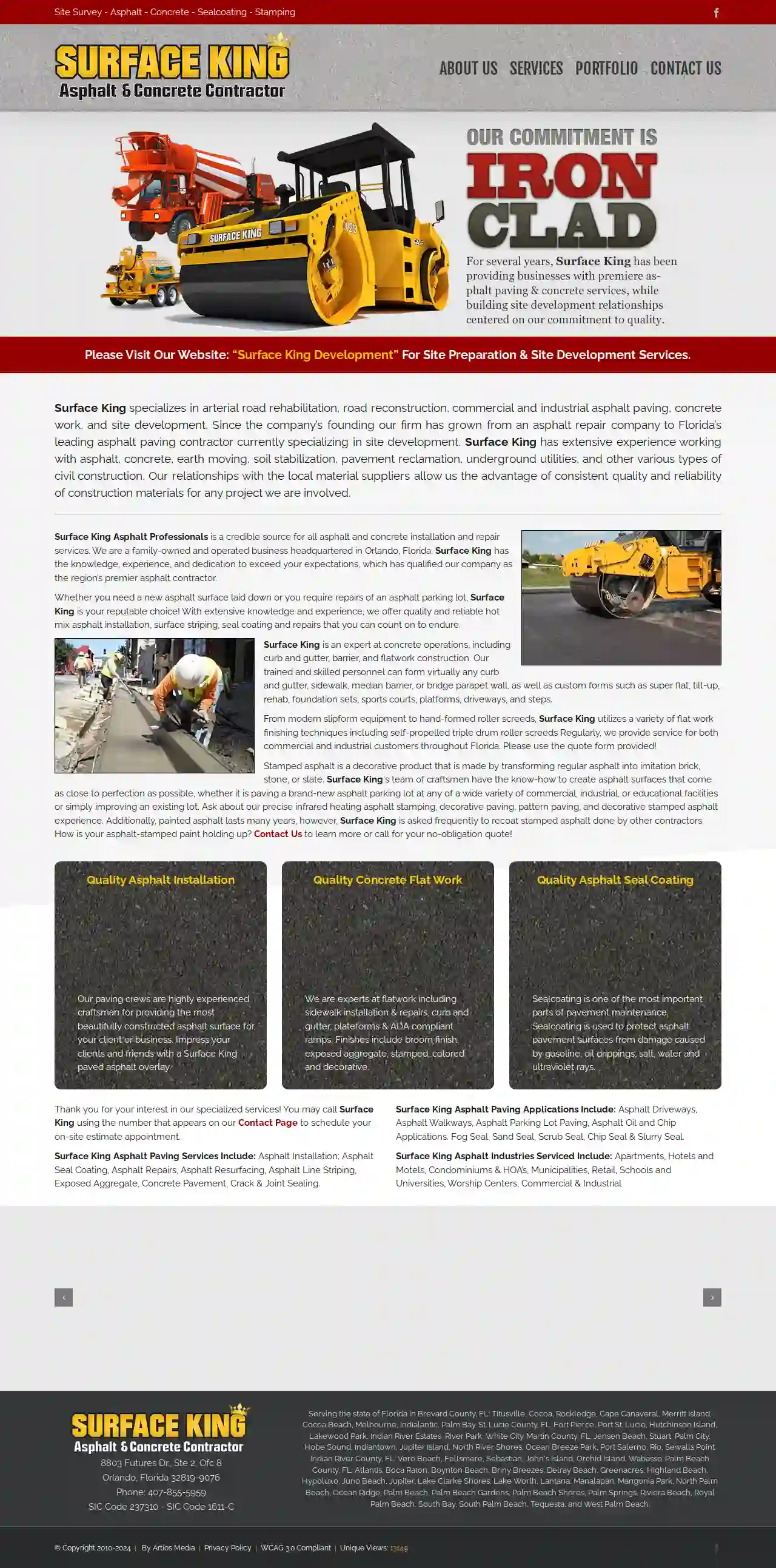
Surface King LLC
54 reviews8803 Futures Dr., Ste 2, Ofc 8, Orlando, 32819-9076, USSurface King: Your Premier Asphalt and Concrete Contractor in Florida Surface King is a family-owned and operated business headquartered in Orlando, Florida. We specialize in arterial road rehabilitation, road reconstruction, commercial and industrial asphalt paving, concrete work, and site development. Our team of experienced professionals has the knowledge, experience, and dedication to exceed your expectations, which has qualified our company as the region’s premier asphalt contractor. Since our founding, we've grown from an asphalt repair company to Florida's leading asphalt paving contractor, specializing in site development. We have extensive experience working with asphalt, concrete, earth moving, soil stabilization, pavement reclamation, underground utilities, and other various types of civil construction. Our relationships with local material suppliers allow us the advantage of consistent quality and reliability of construction materials for any project we are involved in. Whether you need a new asphalt surface laid down or you require repairs of an asphalt parking lot, Surface King is your reputable choice! With extensive knowledge and experience, we offer quality and reliable hot mix asphalt installation, surface striping, seal coating and repairs that you can count on to endure. Surface King is an expert at concrete operations, including curb and gutter, barrier, and flatwork construction. Our trained and skilled personnel can form virtually any curb and gutter, sidewalk, median barrier, or bridge parapet wall, as well as custom forms such as super flat, tilt-up, rehab, foundation sets, sports courts, platforms, driveways, and steps. From modern slipform equipment to hand-formed roller screeds, Surface King utilizes a variety of flat work finishing techniques including self-propelled triple drum roller screeds. Regularly, we provide service for both commercial and industrial customers throughout Florida. Please use the quote form provided! Stamped asphalt is a decorative product that is made by transforming regular asphalt into imitation brick, stone, or slate. Surface King‘s team of craftsmen have the know-how to create asphalt surfaces that come as close to perfection as possible, whether it is paving a brand-new asphalt parking lot at any of a wide variety of commercial, industrial, or educational facilities or simply improving an existing lot. Ask about our precise infrared heating asphalt stamping, decorative paving, pattern paving, and decorative stamped asphalt experience. Additionally, painted asphalt lasts many years, however, Surface King is asked frequently to recoat stamped asphalt done by other contractors. How is your asphalt-stamped paint holding up? Contact Us to learn more or call for your no-obligation quote!
- Services
- Why Us?
- Gallery
Get Quote
Cloud 9 Services, LLC
Tampa, USUnderground Utilities Experts INDUSTRIAL & COMMERCIAL PLUMBING IN TAMPA At Cloud 9 Services, LLC we are the leading plumbing and underground utility company for the Tampa area and have been expertly servicing our clients for over 20 years. We are open 24 hours a day 7 days a week, making us the go-to business for any service or emergency you have day or night. If you have been looking for a company that is efficient, reliable and accessible, you can't go wrong with us at Cloud 9 Services, LLC. Our licensed and certified contractors are ready to take on any project you may have and we look forward to working with you on your future projects. Listed below are some of the services we offer for our commercial and industrial clients. For more information don't hesitate to contact our expert staff, 866-325-6839, they are here to answer any and all questions you may have.
- Services
- Why Us?
- Gallery
Get Quote
Buchanan Land Development Inc
51 reviews17157 40th Run North, Loxahatchee, 33470, USAbout us Welcome to Buchanan Land Development inc., Where excellence meets experience in the world of land excavation and development. With a dedicated focus on precision and adherence to local regulations, we ensure that every project is executed flawlessly. As a family-owned company with over 20 years of industry experience, we take great pride in our work. Our commitment to quality services is underpinned by a foundation of honesty, integrity, and deep knowledge of our craft. Equipped with state-of-the-art tools and equipment, we strive to complete your project on time and within budget, never compromising on the quality of our work. At Buchanan Land Development inc., we are dedicated to delivering superior quality and outstanding results. We approach each project with meticulous attention to detail and a passion for exceeding expectations. With us, you can expect a seamless experience, exceptional craftsmanship, and a final result that reflects our commitment to excellence. The Process Step 1 Contact us effortlessly by calling, emailing, or filling out the form on our dedicated contact page. We eagerly await your message, ready to assist you with your project. Please provide us with details regarding the type of project you have in mind, and if applicable, kindly share any blueprints or plans you may have. Our team will promptly gather the necessary information from you to ensure a smooth and efficient process. We value open communication and are committed to providing you with exceptional service. Step 2 Once you have contacted us and provided an initial idea of your project, our next step is to schedule a site visit. At Buchanan Land Development Inc., we firmly believe in assessing the site firsthand before submitting a bid. This approach ensures accuracy and enables us to fully understand the scope of the project. We value transparency and want to provide you with the most precise and comprehensive proposal possible. Rest assured that we won't proceed with bidding on a project without conducting a thorough inspection of the jobsite. Our commitment to delivering exceptional service starts with a meticulous evaluation of your specific requirements. Step 3 Once we have conducted a thorough site visit and gathered all the necessary information, we will carefully analyze your project and provide you with a detailed and accurate bid. We are committed to transparency and will clearly outline all the costs involved, ensuring that you have a complete understanding of the project's financial aspects. Our goal is to provide you with a fair and competitive bid that reflects the quality of our services and the scope of your project. Step 4 Upon your acceptance of our bid, we will move forward with the project, ensuring that all necessary permits and approvals are obtained. We will keep you informed throughout the entire process, providing regular updates and addressing any questions or concerns you may have. Our commitment to open communication and transparency extends to every stage of the project, ensuring that you are fully involved and informed. Step 5 With meticulous planning and execution, we will complete your project on time and within budget, adhering to the highest standards of quality and craftsmanship. We take pride in our work and strive to exceed your expectations, delivering a final result that reflects our commitment to excellence. Our dedication to customer satisfaction is paramount, and we will ensure that you are completely happy with the outcome of your project.
- Services
- Why Us?
- Gallery
Get Quote
SRQuality Solutions
534 reviewsSarasota, USWelcome to SRQuality Solutions Your Destination for Outdoor Space Upgrades and Remodeling! SRQuality Solutions is a trusted construction company that brings your vision to life. Our team of skilled experts is dedicated to delivering high-quality results with meticulous attention to detail. We proudly serve the Sarasota and Bradenton areas, providing affordable services without compromising on quality. Whether you need outdoor upgrades, pool area remodeling, or stunning walkways and patios, we have the expertise to handle it all. At SRQuality Solutions, we prioritize customer satisfaction and strive to exceed expectations on every project. With our commitment to excellence, your dream project is in capable hands. Contact us today to discover how SRQuality Solutions can make your vision a reality!
- Services
- Why Us?
- Gallery
Get Quote
Over 22,076+ Excavation Contractors on our platform
Our excavation contractors operate in Doral and surrounding areas!
ExcavationHQ has curated and vetted the Best Excavation Businesses arround Doral. Find the most trustworthy business today.
Frequently Asked Questions About Demolition Contractors
- Safety: Experienced contractors have the knowledge, skills, and safety training to execute demolitions safely, minimizing risks to workers and surrounding areas.
- Efficiency: Contractors have the specialized equipment and expertise to complete demolitions efficiently, saving time and reducing project costs.
- Compliance: Reputable contractors are familiar with local regulations and permitting requirements, ensuring compliance and avoiding legal issues.
- Waste Management: Contractors have waste management plans to handle debris responsibly, including recycling and proper disposal.
- Liability Protection: Insured contractors protect you from financial responsibility for accidents or damages during the demolition process.
- Waste Generation: Demolition generates a large volume of debris, contributing to landfill space and potentially releasing harmful substances into the environment if not disposed of properly.
- Air Pollution: Dust and particulate matter released during demolition can impact air quality, affecting human health and the environment.
- Noise Pollution: Demolition activities can generate significant noise, disturbing nearby residents and wildlife.
- Resource Depletion: Demolition consumes resources that could be salvaged and reused, contributing to resource depletion and environmental degradation.
- Size and Complexity of the Structure: Larger and more complex structures, such as multi-story buildings, require more time, labor, and specialized equipment, increasing costs.
- Type of Demolition: Different demolition methods, such as implosion, wrecking ball, or high-reach demolition, have varying costs.
- Material Disposal: Disposal fees for demolition debris can contribute significantly to the overall cost, depending on the type and quantity of materials.
- Location and Accessibility: Demolition in densely populated areas or with limited access may require more planning and specialized equipment, affecting costs.
- Hazardous Materials: The presence of asbestos, lead paint, or other hazardous materials requires specialized removal and disposal procedures, adding to the expenses.
- Dust Suppression: Use water spraying, misting systems, or other dust suppression techniques to control airborne particles.
- Noise Barriers: Erect temporary noise barriers around the demolition site to reduce noise transmission to nearby properties.
- Work Schedule: Schedule noisy demolition activities during permitted hours to minimize disturbance to neighbors.
- Communication: Keep neighbors informed about the demolition schedule and any potential disruptions.
What are the benefits of hiring a professional demolition contractor?
What are the environmental impacts of demolition?
How much does demolition cost in the USA?
How can I minimize the dust and noise from demolition?
What are the benefits of hiring a professional demolition contractor?
- Safety: Experienced contractors have the knowledge, skills, and safety training to execute demolitions safely, minimizing risks to workers and surrounding areas.
- Efficiency: Contractors have the specialized equipment and expertise to complete demolitions efficiently, saving time and reducing project costs.
- Compliance: Reputable contractors are familiar with local regulations and permitting requirements, ensuring compliance and avoiding legal issues.
- Waste Management: Contractors have waste management plans to handle debris responsibly, including recycling and proper disposal.
- Liability Protection: Insured contractors protect you from financial responsibility for accidents or damages during the demolition process.
What are the environmental impacts of demolition?
- Waste Generation: Demolition generates a large volume of debris, contributing to landfill space and potentially releasing harmful substances into the environment if not disposed of properly.
- Air Pollution: Dust and particulate matter released during demolition can impact air quality, affecting human health and the environment.
- Noise Pollution: Demolition activities can generate significant noise, disturbing nearby residents and wildlife.
- Resource Depletion: Demolition consumes resources that could be salvaged and reused, contributing to resource depletion and environmental degradation.
How much does demolition cost in the USA?
- Size and Complexity of the Structure: Larger and more complex structures, such as multi-story buildings, require more time, labor, and specialized equipment, increasing costs.
- Type of Demolition: Different demolition methods, such as implosion, wrecking ball, or high-reach demolition, have varying costs.
- Material Disposal: Disposal fees for demolition debris can contribute significantly to the overall cost, depending on the type and quantity of materials.
- Location and Accessibility: Demolition in densely populated areas or with limited access may require more planning and specialized equipment, affecting costs.
- Hazardous Materials: The presence of asbestos, lead paint, or other hazardous materials requires specialized removal and disposal procedures, adding to the expenses.
How can I minimize the dust and noise from demolition?
- Dust Suppression: Use water spraying, misting systems, or other dust suppression techniques to control airborne particles.
- Noise Barriers: Erect temporary noise barriers around the demolition site to reduce noise transmission to nearby properties.
- Work Schedule: Schedule noisy demolition activities during permitted hours to minimize disturbance to neighbors.
- Communication: Keep neighbors informed about the demolition schedule and any potential disruptions.